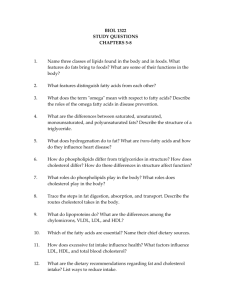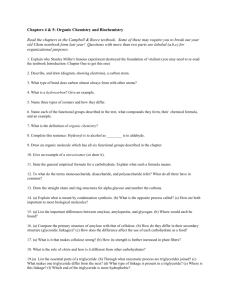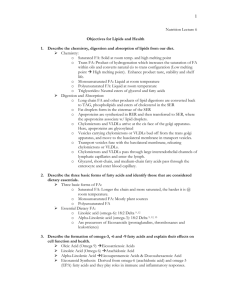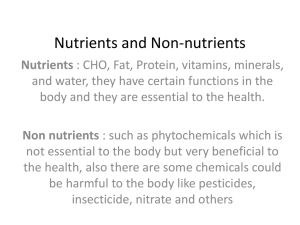19 Nutrition flashcards
advertisement
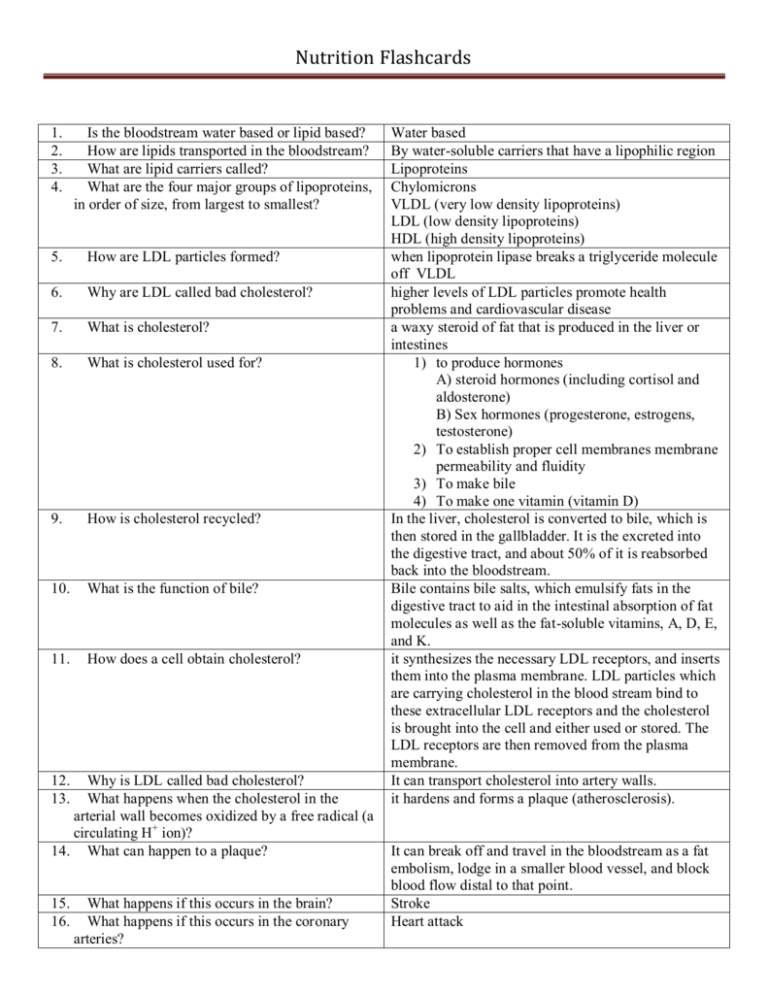
Nutrition Flashcards 1. 2. 3. 4. Is the bloodstream water based or lipid based? How are lipids transported in the bloodstream? What are lipid carriers called? What are the four major groups of lipoproteins, in order of size, from largest to smallest? 12. 13. Water based By water-soluble carriers that have a lipophilic region Lipoproteins Chylomicrons VLDL (very low density lipoproteins) LDL (low density lipoproteins) HDL (high density lipoproteins) when lipoprotein lipase breaks a triglyceride molecule off VLDL higher levels of LDL particles promote health problems and cardiovascular disease a waxy steroid of fat that is produced in the liver or intestines 1) to produce hormones A) steroid hormones (including cortisol and aldosterone) B) Sex hormones (progesterone, estrogens, testosterone) 2) To establish proper cell membranes membrane permeability and fluidity 3) To make bile 4) To make one vitamin (vitamin D) In the liver, cholesterol is converted to bile, which is then stored in the gallbladder. It is the excreted into the digestive tract, and about 50% of it is reabsorbed back into the bloodstream. Bile contains bile salts, which emulsify fats in the digestive tract to aid in the intestinal absorption of fat molecules as well as the fat-soluble vitamins, A, D, E, and K. it synthesizes the necessary LDL receptors, and inserts them into the plasma membrane. LDL particles which are carrying cholesterol in the blood stream bind to these extracellular LDL receptors and the cholesterol is brought into the cell and either used or stored. The LDL receptors are then removed from the plasma membrane. It can transport cholesterol into artery walls. it hardens and forms a plaque (atherosclerosis). 15. 16. It can break off and travel in the bloodstream as a fat embolism, lodge in a smaller blood vessel, and block blood flow distal to that point. Stroke Heart attack 5. How are LDL particles formed? 6. Why are LDL called bad cholesterol? 7. What is cholesterol? 8. What is cholesterol used for? 9. How is cholesterol recycled? 10. What is the function of bile? 11. How does a cell obtain cholesterol? Why is LDL called bad cholesterol? What happens when the cholesterol in the arterial wall becomes oxidized by a free radical (a circulating H+ ion)? 14. What can happen to a plaque? What happens if this occurs in the brain? What happens if this occurs in the coronary arteries? Nutrition Flashcards 17. What predicts whether or not cholesterol is transported into artery walls? 18. What popular medicine group is prescribed for people with high LDL levels? 19. How do these medicines work? 20. If cholesterol synthesis is inhibited, what levels will become elevated in the blood if the person does not cut back on their fat consumption? 21. What are triglycerides? 22. 23. 24. 25. What is the function of triglycerides? What are triglycerides correlated with? How are triglycerides useful? What happens to triglycerides in the small intestine? 26. What is the enzyme that breaks down triglycerides so they can be absorbed in the small intestine? 27. What is the most effective dietary approach to minimize LDL’s in the blood? 28. 29. What are two reasons why is it worse to have a fat belly than to have fat in the rear end, regarding LDL levels? Why is it worse to have a fat belly than to have fat in the rear end, regarding diabetes? 30. What obvious appearance is an indicator of how high your LDL and triglyceride levels are, and therefore, is an indicator of cardiovascular health? 31. What other lipid can be lowered which will reduce LDL levels? How to you lower that lipid? 32. Are LDL particles harmless until they are within the blood vessel walls and oxidized by free radicals? 33. Will ingesting antioxidants, thereby minimizing free radical exposure reduce LDL's contribution to atherosclerosis? 34. Why are HDL particles called "good cholesterol"? High levels of LDL Statins (such as vasostatin). By inhibiting cholesterol synthesis Triglycerides will go up; seen in a blood test. They are the main constituents of saturated and unsaturated fat. They are a mechanism for storing unused calories The consumption of starch and fatty foods They transport dietary fat to cells that need it They are converted to chylomicrons, which are absorbed by lacteals (lymph vessels) Lipase Minimizing fat stores in the greater omentum (reduce fat in the waistline) in addition to minimizing total body fat. 1) Fat stored in the greater omentum is mobilized before subcutaneous fat (deep to the dermis). Fat stored in the rear end is subcutaneous fat. Therefore, fat stored in the omentum will be made into LDL first. 2) Greater omentum fat also produces an enzyme called resistin, which lowers circulating VLDL concentrations (which increases LDL levels). Resistin also increases insulin resistance (causing Diabetes Mellitus) Having a large waist line Triglycerides. Lower them by consuming less fat. Yes Possibly...clinical studies are inconclusive. HDL particles are able to remove cholesterol from within arterial plaques and transport it back to the liver for excretion or re-utilization Nutrition Flashcards 35. Will increasing one's HDL beyond normal limits make you healthier than normal? 36. Where does HDL transport cholesterol? 37. What happens to the cholesterol delivered to the liver? 38. What happens to the cholesterol delivered to adrenal glands, ovaries, and testes? 39. What three properties of HDL contribute to its ability to protect from atherosclerosis? 40. Can you increase HDL by exercise? 41. What three things may increase HDL levels? 42. 43. What are the two categories of triglycerides? What are examples of each? 44. 45. What is the function of triglycerides? What causes high levels of triglycerides in the blood? 46. Are triglycerides directly absorbed in the small intestine? 47. How are triglycerides absorbed? 48. How are triglycerides broken down? 49. How much energy to they contain, compared to carbohydrates and proteins? 50. Triglycerides are an important component of which two lipid transporter proteins? 51. What happens after fatty acids from triglycerides are absorbed in the intestine? 52. 53. 54. Where do the chlyomicrons go? Once chlyomicrons are in the blood, where do they go? What two cells can synthesize and store triglycerides? 55. When glucose levels are low, what does the body require as an energy source? No Mostly to the liver or organs that use cholesterol such as adrenal glands, ovaries, and testes. It is combined with broken-down hemoglobin and converted into the bile, which is then used to break down intestinal fats into small enough particles for digestive enzymes to work. It is used for the synthesis of steroid hormones. inhibits oxidation, inflammation, and coagulation by platelets No, your levels are hereditary Niacin (vit B3) and magnesium, Apo-A1. Note: Vitamin C does not raise HDL levels. Saturated and unsaturated fatty acids Vegetable oil (typically unsaturated) Animal fats (typically saturated) They are a mechanism for storing unused calories consumption of starchy and fatty foods No, they are too large. The pancreatic enzyme lipase acts releases the fatty acids so they can be absorbed (lipolysis). They are broken down to fatty acids and then the fatty acids are absorbed by the small intestine. More than twice as much VLDL and chylomicrons. They enter the cells that make up the intestinal lining, where they are rebuilt and packaged with cholesterol and proteins to form chylomicrons. They are collected by the lymph system (lacteals in the intestinal villi), which transport them to the thoracic lymph duct, and are dumped into the subclavian vein to be mixed into the blood. Various tissues can capture the chylomicrons, releasing the triglycerides to be used as a source of energy when glucose is not available. Fat and liver cells fatty acids Nutrition Flashcards 56. What hormone signals the liver to break glycogen down into glucose and if that is not enough glucose, it will start gluconeogenesis? 57. What enzymes are involved in gluconeogenesis? glucagon 58. 59. 1) Lipase, which breaks down triglycerides to release free fatty acids, and 2) proteases to break down proteins into amino acids. The fatty acids and amino acids are then combined to make new glucose. glucagon No. The brain can only use glucose 62. the glycerol component of triglycerides can be converted into glucose by way of glycogenolysis. Probably not, but high levels are present in people with heart disease. 60% What hormone signals the production of lipase? When glucose levels are low, can the brain utilize fatty acids as an energy source? 60. How can the brain get more glucose when there is not enough? 61. Do triglycerides cause heart disease? What percentage of your diet being from carbohydrates will increase your blood triglyceride levels, especially if you have diabetes or are overweight? 63. When a high carbohydrate diet causes high levels of triglycerides in the blood, what is the condition is called? 64. What does carbohydrate-induced hypertriglyceridemia do to a person’s glycemic index? What does that do to insulin levels? 65. What is the function of insulin? 66. What happens when cells are resistant to insulin? 67. What is the best food to reduce triglyceride levels? 68. What does it mean that Omega 3 fatty acids are essential? 69. What are some good things about Omega 3 fatty acids? 70. 71. What is the best source of Omega 3 fatty acids? Why should you avoid Omega-3 fatty acids from fish oil, even though they are heavily advertised? 72. What is the glycemic index? 73. What makes a particular carbohydrate have a high glycemic index? What is an example of one? carbohydrate-induced hypertriglyceridemia Elevates it, causing an overproduction of insulin It pulls glucose into the cells. If a cell is insulin resistant, the glucose will stay in the blood and spill into the urine. High levels of blood sugar will damage the brain and blood vessel lining. Up to 3 grams a day of omega-3 fatty acids from flax seed oil (linseed oil). They are not made in our body, so they are needed in our diet. They are essential to normal growth in young children. In adults, they may improve rheumatoid arthritis, cardiovascular disease, and cancer. Flax (linseed) and its oil Because fish oils are too high in vitamin A, which is toxic in high levels. a measure of the effects of carbohydrates on blood sugar levels. Carbohydrates that break down quickly during digestion and release glucose rapidly into the bloodstream. Simple sugar like glucose is an example. Nutrition Flashcards 74. What is an example of a carbohydrate with a low glycemic index? 75. What carbohydrates have slower rates of digestion and absorption, causing a lower insulin demand, and are thus better for a diabetic? 76. What is the Body Mass Index (BMI)? 77. What two things are used to calculate BMI? 78. Does BMI actually measure the percentage of body fat? 79. What is the quickest, most readily available source of energy for the body? 80. What are carbohydrates broken down into? 81. What is broken down if there is not enough blood glucose between meals? 82. 83. What are simple carbohydrates? What are examples of simple carbohydrates? 84. Why are sugars called empty calories? 85. What are examples of complex carbohydrates? 86. Name some foods rich in protein 87. What happens to proteins that you eat? Starch Foods with a lower glycemic index An estimate of body fat Weight and height No…you would have to weigh yourself in a swimming pool to calculate that. Glucose Glucose Triglycerides are broken down into fatty acids and proteins (including heart muscle) are broken down to amino acids, which combined and made into new glucose sugars ice cream, cakes, and cookies. Plain white sugar from a box (called refined sugar) because they contribute to energy needs and weight gain without supplying any other nutritional requirements. whole grain pasta, rice, bread, and cereal. Less desirable complex carbohydrates (not good for overweight people) are potatoes and corn red meat, fish, poultry, dairy products, legumes (i.e., peas and beans), nuts, and cereals They are broken down into amino acids and turned into tissues like muscles, skin, hair, and nails. It’s also used to make proteins such as hemoglobin, plasma proteins, enzymes, and hormones. 88. How many amino acids are used to make all the 23 proteins in our body? 89. What are essential amino acids? There are 9 amino acids which are called “essential” 90. How many are there? required from the diet in adults because the body is unable to produce them. 91. What food contains all 23 types of amino Meat acids? 92. What happens if one amino acid is missing The other 22 might not work right. from the diet? 93. What combination of food provides all the Cereal with milk and rice with beans or peas essential amino acids? 94. Are amino acids stored in the body? No, a daily supply is needed. 95. How much meat does a person need per day? Two servings (the size of a deck of cards) Nutrition Flashcards 96. Which meats are high in protein but also high in fat? 97. What protein sources are low in fat? 98. Why are protein and amino acid supplements not good? 99. What happens if you have an excess of just one amino acid? 100. What type of fats raise LDL (bad) cholesterol? Name 2 examples 101. What type of fats lower LDL (bad) cholesterol? Name 2 examples 102. What are two plant oils that are NOT good, because they contain saturated fats? 103. Which meats are lower in saturated fats? 104. How many calories are in one pound of fat? 105. How many days will it take to lose one pound of fat if you eat 500 calories less per day? 106. What is the reason why some people lose more than that? 107. What are the two general function of vitamins? 108. What is an enzyme? 109. How many vitamins are there, and what are their 2 categories? 110. What are the 4 fat-soluble vitamins? 111. What happens to excess fat-soluble vitamins? 112. What happens to excess water-soluble vitamins? 113. Where is the fat on a fetus? What happens if the mother takes too much vitamin A, D, E, or K? 114. Where is vitamin C found? 115. Where is vitamin D made? 116. What does vitamin D do? 117. Lack of vitamin D leads to what disorder in children? 118. What is a free radical? Red meat (can be 42% fat) protein from plant origins (whole-grain cereals, dark breads, and legumes) They are not digested as well They can cause you to have an excess of one amino acid or another It competes for receptor sites in the small intestine, causing a deficiency in absorption of the other amino acids. Saturated fats; they are solid at room temperature and have an animal origin. Butter and margarine polyunsaturated fats; they are liquid at room temperature and have a plant origin. olive oil, canola oil, corn oil, and safflower oil. partially hydrogenated palm and coconut oil Turkey, fish, and chicken. 3,500 7 days Water loss. It will come back. They are needed for metabolism They make a lot of the body’s enzymes. It breaks a larger molecule down into smaller ones. 13 vitamins; fat soluble and water soluble A, D, E, K They are stored in fat and liver, and can accumulate to a toxic level They are excreted in the urine. That is okay as long as you are well hydrated. If not, they can cause kidney damage. In the myelin sheaths (white matter). Excess vitamins can lodge there and disrupt action potentials. The corpus callosum is a large area of white matter in the brain. Dysfunction causes autism. Citrus fruits (oranges, tangerines, lemons) In the skin after UV light exposure. Helps the intestines absorb ingested calcium Rickets As a cell is functioning, it generates molecules that have an extra electron, which is called a free radical. Nutrition Flashcards 119. What is the damage caused by free radicals? free radicals want to run around and get rid of their extra electron (that is called oxidizing the recipient molecule), but none of the other molecules want one, either. The parts of a cell that usually get stuck with a free radical include DNA, proteins, enzymes, and cell membranes. This leads to damage there, and can even lead to cancer. 120. What substances deactivate free radicals? What Anti-oxidants are examples? Vitamin C. E, and A, found in fruits and vegetables 121. How many servings of fruits and vegetables 5 servings (2 fruit, 3 vegetables). A serving is about should you eat per day? one cup 122. Is it just as good to take a vitamin pill instead of No, you don’t get the fiber, which is needed to prevent eating fruits and vegetables? colon cancer. Also, excess vitamins A, D, E, K are toxic 123. What are some minerals? Calcium, phosphorous, iodine, sodium, chloride, magnesium, potassium, zinc, copper, iron 124. What is calcium used for? bones, teeth, nerve conduction, and muscle contraction. It helps prevent osteoporosis if you have enough calcium and you also exercise. 125. What foods are high in calcium? Dairy products and green leafy vegetables 126. What is phosphorus used for? It is used as an energy molecule. It is part of ATP 127. What is iodine used for? Thyroid hormone 128. What are sodium and chloride used for? Regulating water balance 129. How much sodium is needed per day? What 500 mg/day. Excess causes water retention, causing happens if you have too much? high blood pressure 130. What is potassium and sodium used for? Muscle contraction and nerve conduction 131. What are some foods high in potassium? Cantaloupe, avocados, potatoes, beans, bananas, fish, raisins, apricots, dates, and cocoa powder (think chocolate). 132. What is magnesium used for? Helps muscles relax 133. What are some foods high in magnesium? seeds, brans (wheat, rice, and oat), spinach, and cocoa. Any leafy greens have a high amount of magnesium because the center of the chlorophyll molecule is magnesium. 134. What is magnesium, zinc, and copper used for? They are critical for most enzymes 135. What is iron used for? To make hemoglobin to transport oxygen in red blood cells 136. How do males and females differ in their iron Females need more, due to loss during menstruation. requirements? If you ingest too much, it makes you constipated. 137. What is glucosamine? Where in the body is it an amino sugar and a prominent precursor in the found? synthesis of certain proteins and lipids. It is an important component of joint cartilage 138. How are glucosamine supplements made? Usually from the shells of crustaceans Nutrition Flashcards 139. Will ingesting glucosamine restore damaged cartilage? 140. Name three common eating disorders 141. What is obesity? 142. What is moderate obesity? 143. What is morbid obesity? 144. Why is it especially important not to let children become obese? 145. What surgery is for people more than 100 pounds overweight? 146. What are the problems with this surgery? 147. What is bulimia? 148. What are the dangers of bulimia? 149. What is anorexia? 150. What is anorexia nervosa? 151. Who is especially at danger for anorexia nervosa? 152. What are some symptoms of starvation? No; eating cartilage does not mean you will grow new cartilage. It just breaks down into the same components that are found in cartilage. It may or may not be used to restore cartilage (controversial; no evidence to support it yet). It might prevent cartilage erosion (also controversial). Obesity, bulimia, anorexia nervosa Being about 50 pounds overweight Being about 75 pounds overweight Being 200+ pounds overweight Their stem cells have not all differentiated yet. If they gain weight, these stem cells will become fat cells, and it will be hard for them to lose weight their whole life. Stomach stapling. They have to watch their diet to get enough nutrients, they need vitamin B12 shots monthly, and they must not force extra food in, or the stomach will stretch out again. eating to excess (called binge eating) and then purging themselves by some artificial means, such as selfinduced vomiting or use of a laxative. causes an abnormal heart rhythm, and damage to the kidneys can even result in death. Vomiting up the food causes the stomach acids to eat away at the pharynx, esophagus, and teeth. Vomiting also causes loss of electrolytes, which can be deadly Anorexia is just “not eating”. The person might just be sick or recovering from surgery. Anorexia nervosa is a refusal to eat because they think they are too fat. It is often a control issue. The person feels like they do not have control in their life, so they control the food. Athletes such as distance runners, wrestlers, and dancers low blood pressure, irregular heartbeat, constipation, being cold, and they tend to get stress fractures. Menstruation ceases in females



